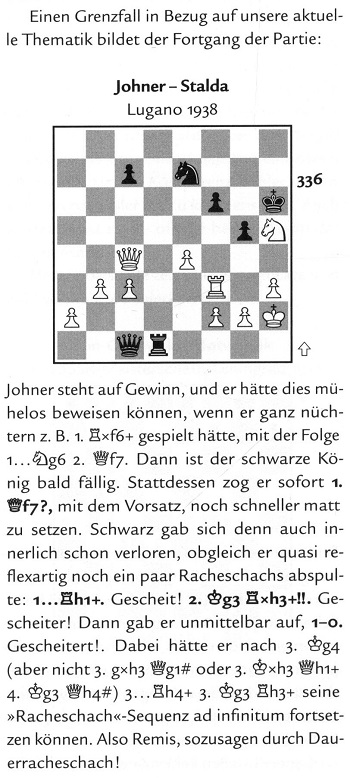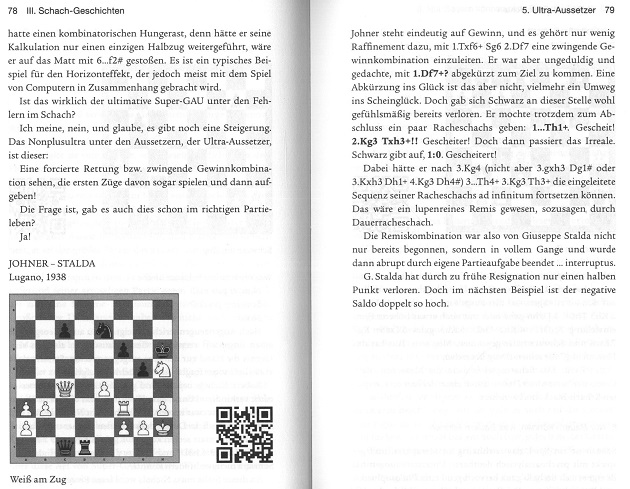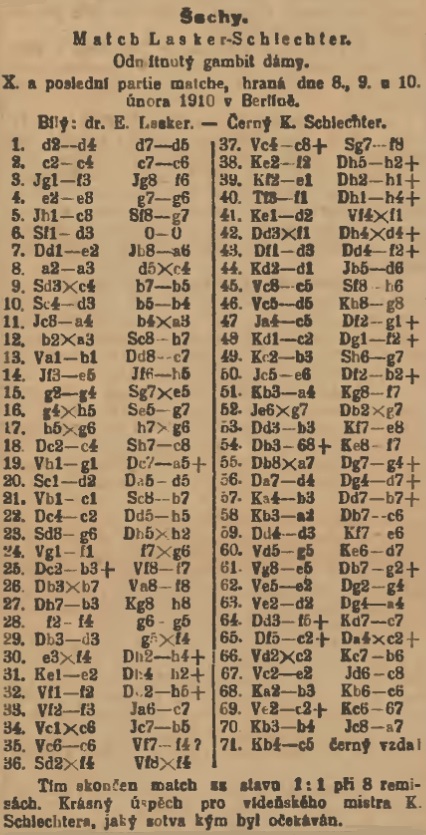Chess Notes
Edward Winter
When contacting us by e-mail, correspondents are asked to include their name and full postal address and, when providing information, to quote exact book and magazine sources. The word ‘chess’ needs to appear in the subject-line or in the message itself.
| First column | << previous | Archives [134] | next >> | Current column |
9455. Photographic archives (4)
Another picture from our collection:
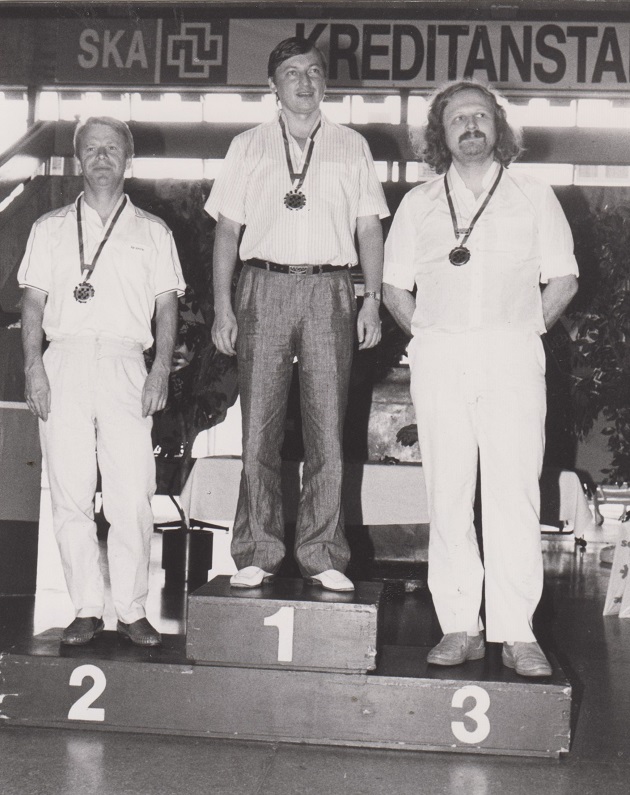
Ulf Andersson, Anatoly Karpov, Tony Miles (Biel, 1990)
9456. Capablanca v Karff (C.N. 9447)
The conclusion of the 1941 game between Capablanca and Mona Karff received a full page (364) in American Chess Art by Walter Korn (London, 1975) with the caption ‘Position in diagram with colors reversed’. The final moves were therefore given as ‘1 Q-B6 Q-Q1 2 RxRPch’.
Olimpiu G. Urcan (Singapore) has forwarded a report in the 5 February 1942 issue of the New York Sun (Sports section, page 28):
‘The Falkirk Herald of 7 January, received here yesterday, reprints from the New York Sun the score of the game which Miss N. [sic] May Karff won from José R. Capablanca when the Cuban master gave his exhibition of simultaneous play at the Marshall Chess Club. The chess editor, A.J. Neilson of Glasgow, who has been conducting his weekly column for upward of 40 years, comments on this game as follows:
“With the lesser-pieces exchanged, and only the heavy-metal and plenty of pawns remaining, Miss Karff worked in quite an uncommon finish; her queen and apparently widely-separated rooks suddenly co-operating in deadly style – a surprise for Capa no doubt!”’
Our correspondent observes:
‘Although it remains unclear when exactly the game-score was first given in the New York Sun, it was indeed reproduced on page 8 of the 7 January 1942 issue of the Falkirk Herald, with 25 Qe1 Rxa2+ as the conclusion (and a slightly inaccurate final tally for Capablanca in the display).’
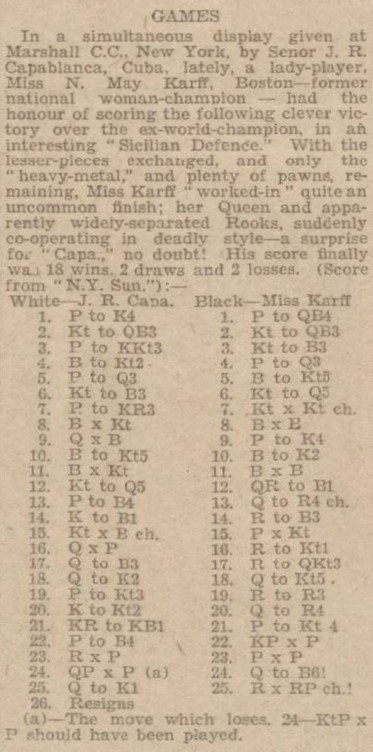
Further to his comments in C.N. 9447, Mr Urcan specifies that Miguel A. Sánchez described the game as ‘an unexpected defeat’ for Capablanca because he considered that White had achieved a ‘material and positional advantage’. The remark did not relate to Mona Karff’s general status or playing strength.
Notwithstanding our own brief observations in C.N. 9434 about the book’s (self-evident) superiority over Sánchez’s two-volume work in Spanish (1978), it is disconcerting to see so many obvious errors on the page following the Capablanca v Karff game (i.e. in the bibliography, on page 535).
A random dip has also revealed the inclusion, even, of the Lasker ‘two male pigeons’ yarn (page 198) and, on page 399, unscholarly treatment of Capablanca’s game against Mary Bain: ‘The story goes that ...’; ‘According to some versions ...’; ‘according to others ...’ The next paragraph turns to another topic, beginning: ‘It is fair to assume that ...’ The following paragraph affirms that a story ‘is almost certainly apocryphal, and probably stemmed from the fact that ...’ A few lines later, a ‘rumor’ is mentioned, but deemed ‘also probably untrue’. The final sentence of that paragraph begins, ‘It is also said that ...’, and two lines later comes another ‘probably’.
9457. Biographies and autobiographies
As discussed on page 105 of our book about Capablanca, diverging opinions have been expressed on the quality of My Chess Career (London, 1920).
In his column ‘Half a Century Back. Chess in 1920’ W.H. Cozens wrote on page 354 of the December 1970 BCM:

That reference to Tarrasch’s autobiographical collection (published in 1894/95) came to mind when, earlier today, we opened the latest McFarland production, Joseph Henry Blackburne. A Chess Biography by Tim Harding. From page 1, after some critical remarks about Mr Blackburne’s Games at Chess:
‘To be fair to Blackburne, he was the first leading master to compile a book about his career, and in 1899 there was no template for how to do it.’
Harding’s book starts unfortunately (the first line of the first chapter, on page 7, is: ‘Joseph Henry Blackburne was born on 10 December at 1841’) and, it must be said, the work as a whole would have benefited from greater attention to certain C.N. material (e.g. C.N. 7324). Even so, any critic with the new Sánchez and Harding books before him should recognize at once the overwhelming superiority of the latter. We look forward to reading both volumes from cover to cover, but the Blackburne one will take precedence.
9458. Mr and Mrs Pillsbury
Gerard Killoran (Ilkley, England) draws attention to a chess article by Rhoda A. Bowles on pages 143-149 of volume nine of Womanhood (December 1902-May 1903). This forgotten photograph of H.N. Pillsbury is on page 144:
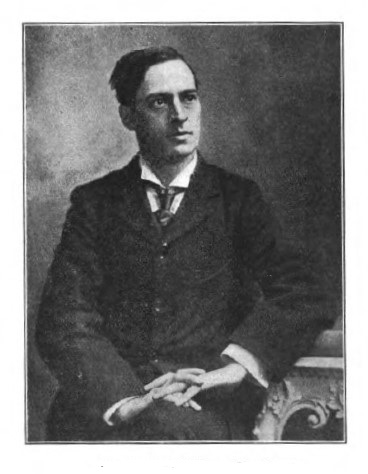
Pages 144-146 reported on a game of living chess (Pillsbury v H.L. Bowles) and a two-move problem composed by Pillsbury. These matters were discussed in C.N. 702 (see pages 184-185 of Chess Explorations). The photograph below is from page 145 of the Womanhood article:
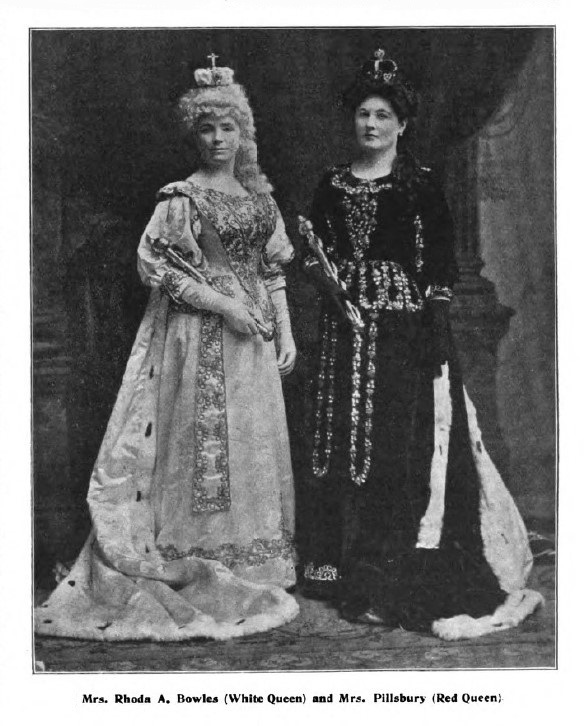
9459. Christian Hesse
From Peter Anderberg (Harmstorf, Germany):
‘Christian Hesse copies his own errors too. From page 233 of his book Expeditionen in die Schachwelt (Nettetal, 2006):
Wrong position, wrong venue, wrong winner.
Hesse discussed the game again on page 59 of the 3/2007 issue of KARL:
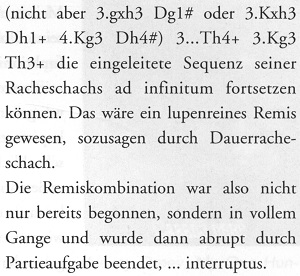
Another position, but also wrong, and again the wrong venue and wrong winner.
On page 5 of the 4/2007 issue of KARL Hesse’s mistakes were pointed out by Richard Forster:

Thus Hesse replied that he would not use the position again in such a way. Richard Forster’s corrections were incorporated (without acknowledgement, and without the revised text being made logical) on pages 242-243 of the English edition of Expeditionen in die Schachwelt – The Joys of Chess (Alkmaar, 2011) – but below is what appeared on pages 78-79 of Hesse’s book Damenopfer (Munich, 2015):
Once more, wrong position, wrong venue and wrong winner.’
9460. Johner v Stalda
From pages 136-137 of the September 1938 Schweizerische Schachzeitung (referred to by Richard Forster in KARL, as shown in the previous item):

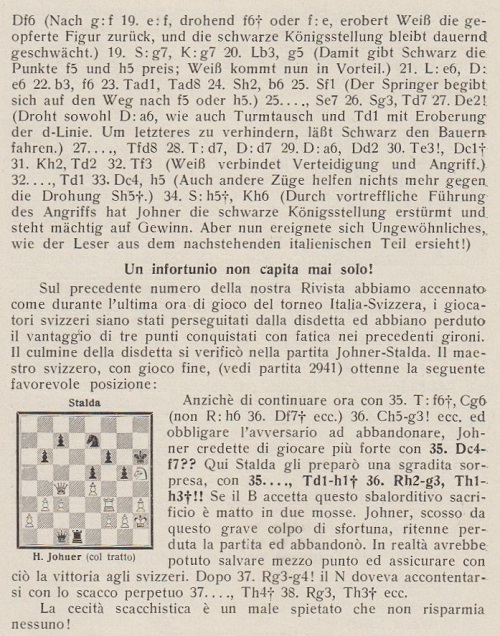
9461. D.J. Morgan
Much biographical information about D.J. Morgan appears in his son’s memoirs, which have just been published: My Histories by Kenneth O. Morgan (Cardiff, 2015).
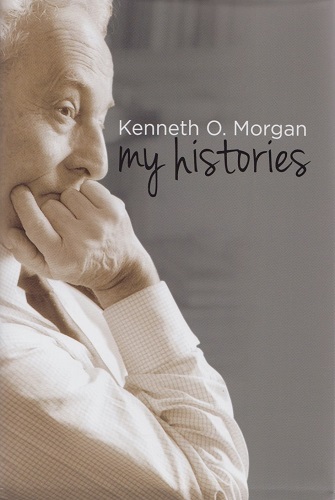
Page 6 refers to D.J.M.’s encounter with Alekhine in 1923 and states:
‘He was a quiet scholarly person of extraordinarily broad culture. Indeed, I think he was probably the ablest man I have ever known, and I was truly fortunate to have him as a father.’
And from page 7:
‘His abiding interest was chess – both problems and games – which gave scope both for his mathematical gifts and his abilities as a crisp writer. He wrote a famous monthly column “Quotes and Queries” for the British Chess Magazine right down to the month of his death in 1978. I was delighted in Aberystwyth, in 1995, when we appointed a History Professor who told me he had read my father’s column avidly. For him, I was just the son of the famous D.J. Morgan and I was overjoyed to know it.’
The Professor was William D. Rubinstein.
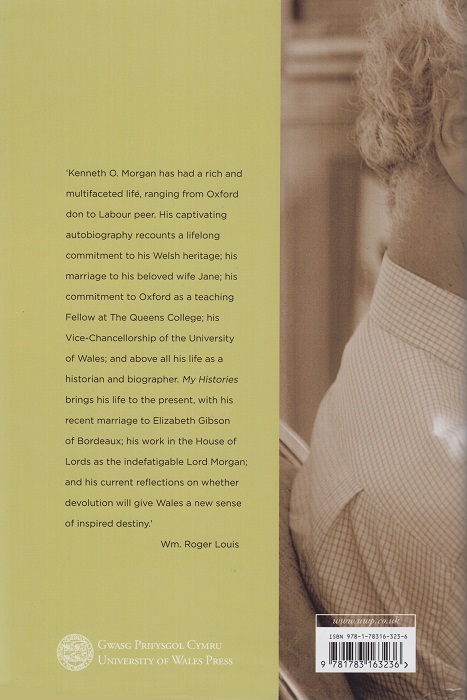
With Professor Lord Morgan’s permission, we reproduce a photograph from the first plate section:
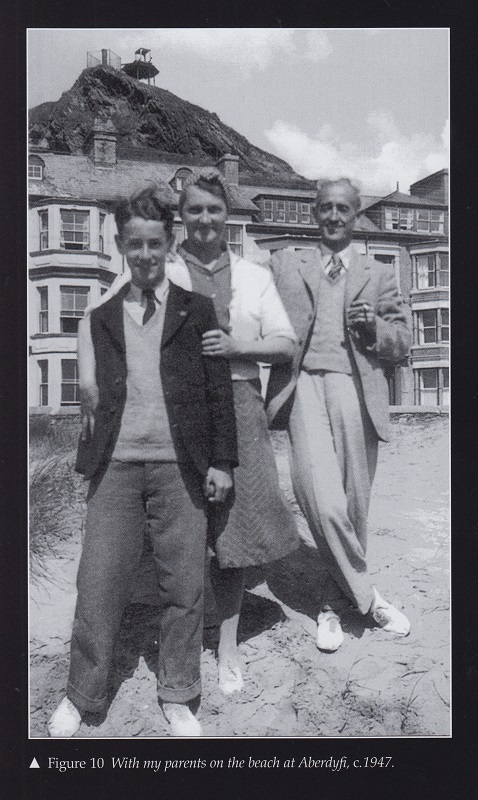
9462. Lee and Gossip
A particularly interesting photograph in Tim Harding’s new book on Blackburne (C.N. 9457) is on page 296: F.J. Lee v G.H.D. Gossip, New York, 1893 (‘courtesy Cleveland Public Library Special Collection’). We are grateful to the Library for authorization to show it here:
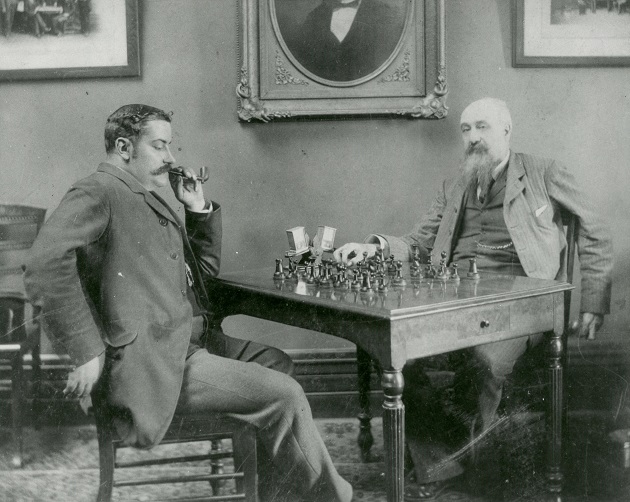
9463. Shipley, Lasker and Pillsbury
In a readily available exhibition game (Ruy López) between Walter Penn Shipley and Emanuel Lasker (Philadelphia, 10 November 1902) Shipley lost a lengthy ending. After giving the score on page 148 of her Womanhood column (C.N. 9458), Rhoda A. Bowles wrote:
‘At the conclusion of this game Mr Shipley said he felt proud to have held out so long against the finest endgame player in the world, a compliment the champion modestly disclaimed, stating that he thought Mr Pillsbury was the best endgame player. The latter, though gratified at the high appreciation bestowed by his friend and rival, will not claim the pre-eminence. This is pretty courtesy, and worthy of absolutely the two finest exponents of chess the world has ever known.’
Shipley’s annotations to his game against Lasker were published in the American Chess Weekly, 15 November 1902 and reproduced on pages 249-251 of Walter Penn Shipley. Philadelphia’s Friend of Chess by John S. Hilbert (Jefferson, 2003).
9464. Johann Maelzel
Ross Jackson (Raumati South, New Zealand) owns this card:
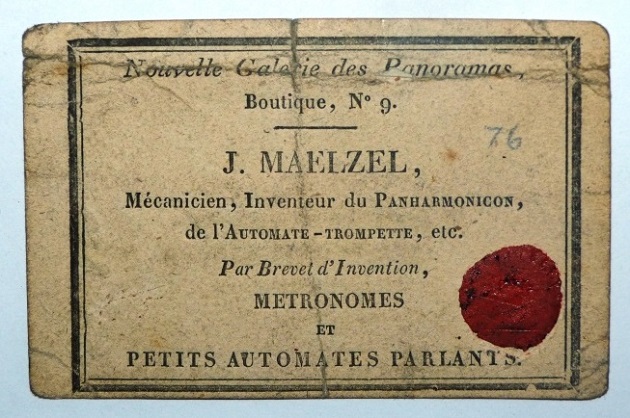
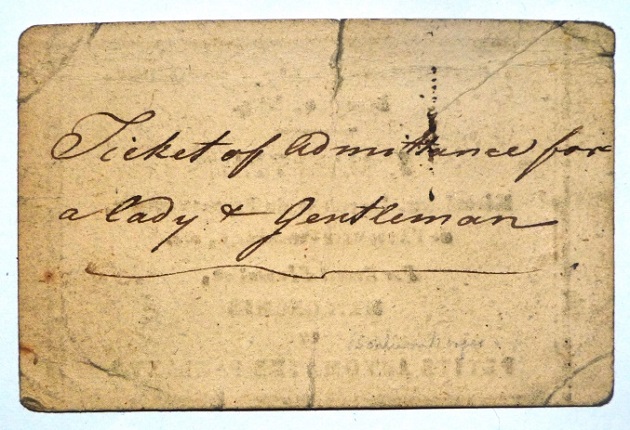
Another specimen of the card was published on page 81 of Chess: Man vs Machine by Bradley Ewart (London, 1980) and on page 44 of The Turk, Chess Automaton by Gerald M. Levitt (Jefferson, 2000).
9465. Duchamp and Le Lionnais
From Oliver Beck (Seattle, WA, USA):
‘In “Echecs et Maths”, an essay on pages 42-51 of Marcel Duchamp: abécédaire, approches critiques edited by Jean Clair (Paris, 1977), François Le Lionnais claimed that although he and Marcel Duchamp were brought together through Dada and a strong philosophical and artistic affinity, their long friendship ultimately resulted from a shared interest in chess. He then provided an interesting summary of Duchamp’s chess career.
On pages 46-47 Le Lionnais gave some background information on his win over Duchamp during the Fifth Tournament of the Cercle Caïssa in 1932, a game published on pages 24-26 of the January 1933 Wiener Schachzeitung with Tartakower’s annotations. It was this game that prompted Ralph Rumney to interview Le Lionnais about Duchamp’s chess, and that resulted in Rumney’s “Marcel Duchamp as a Chess Player and One or Two Related Matters”, which was originally published in Studio International (January-February 1975). The interview, which can be found on pages 196-199 of The Map is Not the Territory by Rumney and Alan Woods (Manchester, 2000), is often cited in the many discussions on the correlation between Duchamp’s art and chess, and particularly regarding the common assertion that an avant-garde artist would naturally be a proponent of hypermodern chess. With this in mind, Rumney’s own observations about chess become especially interesting. On pages 85-87 of his autobiographical work Le Consul (Paris, 1999) he described playing chess with Duchamp at a reception following an art event:
“Il m’a dit: Allons dans la pièce d’à côté. Il y avait un échiquier créé par Max Ernst. J’avais créé un jeu d’échecs que je préfère à celui de Max Ernst. Il a aujourd’hui disparu dans la nature, mais l’un de mes projets avant de mourir est de le retrouver ou de le recréer. Duchamp m’a dit: Est-ce que tu sais jouer aux échecs? Comme ça on peut causer. Pendant le jeu, il a commencé à tendre de petits pièges. Il s’est laissé battre. Je joue aux échecs d’une manière très ordinaire. Les échecs, ce n’est pas un jeu d’intelligence mais un jeu de mémoire et de calcul. C’est comme le poker, comme presque tous les jeux dits de hasard que l’homme a su inventer, c’est bête comme ses pieds. Si tu sais retenir tout ce qu’il faut, tu gagnes. Si tu as la mémoire qui flanche, tu perds.”
In “Echecs et Maths” Le Lionnais mentioned too that his friendship with Duchamp was consolidated through their mutual admiration of Raymond Roussel.
An event not referred to in “Echecs et Maths” is a simultaneous exhibition in which Alekhine faced 36 teams in Paris on 15 June 1935. Details of the event are on page 60 of Le Lionnais’ Le Jardin des échecs (Paris, 1936), and the next two pages published Alekhine’s loss (included on page 526 of the Skinner/Verhoeven book on Alekhine) to Equipe de VU, a team consisting of Le Lionnais, Mmes Vogel and Melikoff, MM. Casciani, Melikoff and Wissiotzky.
C.N. 7796 gave Alekhine’s loss to the team comprising Pierre Biscay, Marcel Berman and Duchamp. Alekhine’s overall result was +27 –6 =3.
Page 46 of “Echecs et math” had a photograph of the French chess team (Kahn, Alekhine, Betbeder, Duchamp and Voisin) on a balcony during the 1933 International Team Tournament in Folkestone.’
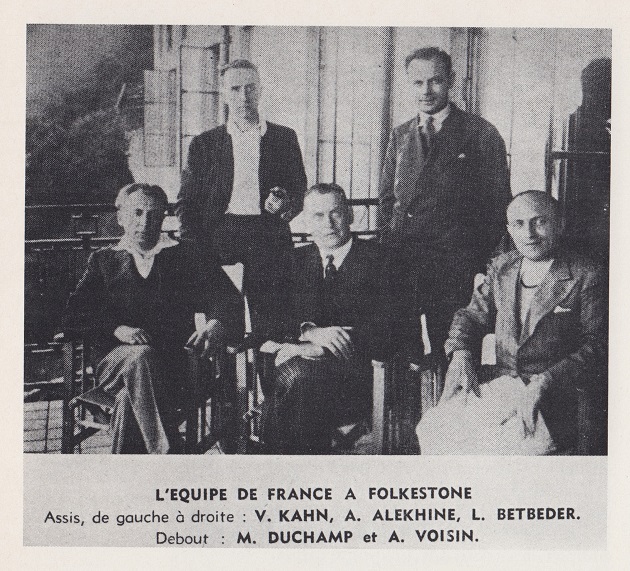
9466. Tsar Nicholas II
From page 230 of How To Play Winning Chess by John Saunders (London, 2007):
‘The title of grandmaster first came into frequent use in chess when Tsar Nicholas II conferred it upon the participants of the 1914 St Petersburg chess tournament. The five players – world champion Emanuel Lasker, future champions José Raúl Capablanca and Alexander Alekhine, plus Siegbert Tarrasch and Frank Marshall – were the leading players of their day and fully deserved the honour.’
The same text, with the same photograph of the Tsar, is on page 236 of The Practical Step-by-Step Guide to Chess & Bridge by David Bird and John Saunders (London, 2010) and on page 236 of the same authors’ The Complete Step-by-Step Guide to Chess & Bridge (London, 2015). The chess content of the three books is more or less identical.
As mentioned in C.N. 9317 (see Chess Grandmasters), the Tsar story lacks proof and should not be repeated without reservation.
9467. Photographic archives (5)
This photograph from our collection was taken at the 1989 Imperia tournament:
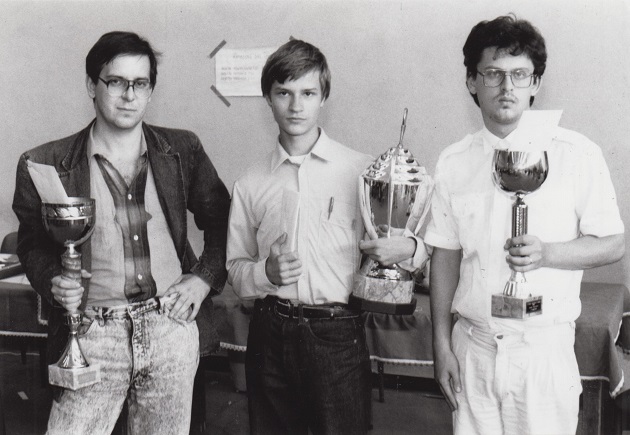
Alex Yermolinsky, Sergei Tiviakov, Lembit Oll
They each scored 6½ points (L’Italia Scacchistica, November 1989, page 318). On pages 69-70 of the 6/2009 New in Chess Yermolinsky wrote that they had agreed upon a three-way tie the night before the final round.
9468. Unlovely words
Chess and the English Language includes a 1988 citation for ‘uncastleable’, in connection with the king. Another unusual, though older, word is ‘unqueenable’. A heading on page 88 of Easy Guide to Chess by B.H. Wood (Sutton Coldfield, 1942) was ‘That unqueenable rook’s pawn’, and the word was also used, within quotation marks, on page 110 of CHESS, February 1950.
9469. Mate in two
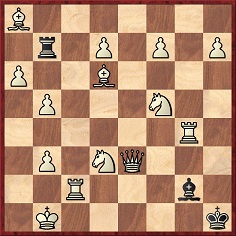
9470. Petrosian
Jean-Pierre Rhéaume (Montreal, Canada) asks about the transliteration of Tigran Petrosian’s surname, given that the feature article Petrosian’s Games has the following:
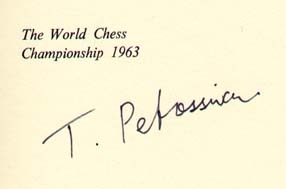
This comes from our copy of The World Chess Championship 1963 by R.G. Wade (New York, 1964), and the inscription was obtained by the book’s previous owner, Alan Benson. What other specimens exist of Petrosian’s signature in the Roman alphabet, and did he customarily write ‘Petrossian’ (the standard spelling in French-language publications)?
‘Petrosyan’ is sometimes seen. CHESS favoured ‘Petroshan’, for the reasons set out (under the heading ‘A matter of pronuncipetrosiation’) on page 137 of its March 1959 issue:

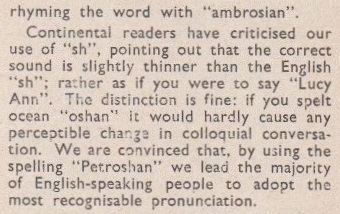
9471. Petrosian v Fischer, 1971
Unlikely as it may seem, the 1971 Candidates’ Final match prompted a set of five chess cartoons by Bill Tidy on pages 494-495 of Punch, 13 October 1971. The first one is indicative of their standard:
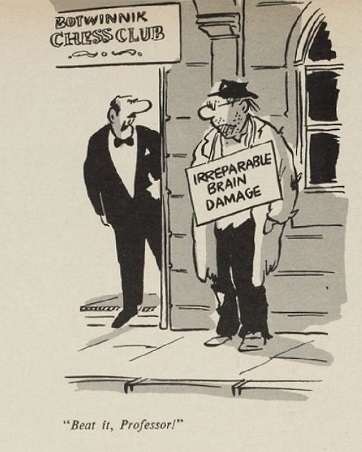
9472. Nineteenth-century players (C.N.s 8705, 8817 & 9437)
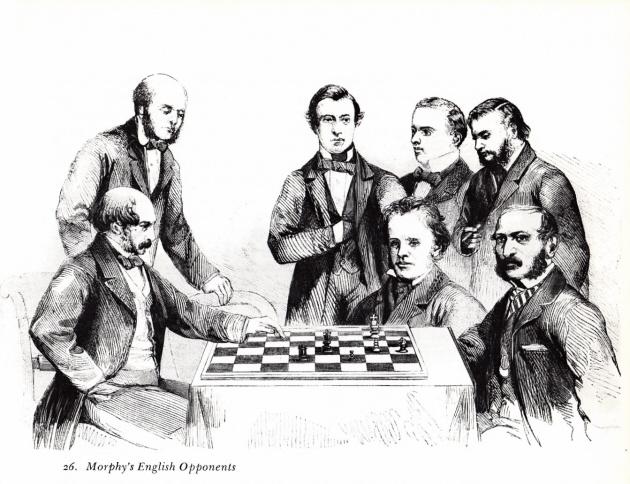
From page 105 of Paul Morphy The Pride and Sorrow of Chess by David Lawson (New York, 1976)
Fabrizio Zavatarelli (Milan, Italy) reports that the picture was published in the Illustrated News of the World, 14 September 1861 with the following key (left to right): H.A. Kennedy, T. Hampton, S.S. Boden, C.H. Stanley, L. Paulsen, I. Kolisch and J. Löwenthal. The heading was: ‘Great chess match between London and Bristol, Thursday, 12 September 1861. Group at the Athenæum, Bristol.’
Thus David Lawson’s caption, ‘Morphy’s English Opponents’, was not only vague but inaccurate.
As reported on, for instance, page 3 of the Morning Chronicle, 13 September 1861, the London v Bristol match was played by electric telegraph and comprised one consultation game and six single-handed games.
The many detailed press reports on the match which were published on 13 September, or shortly afterwards, are a reminder of the astounding speed with which newspapers operated at that time.
9473. Photographic archives (6)
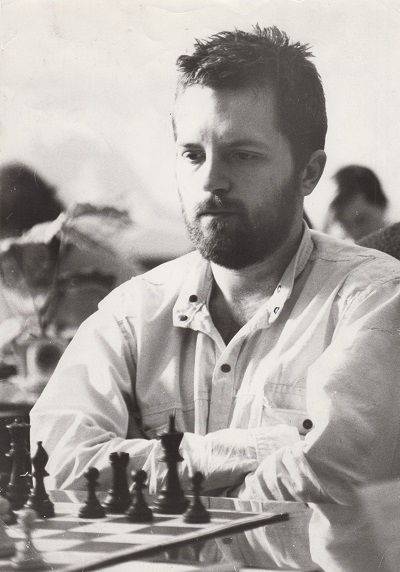
Aleksander Wojtkiewicz
9474. Accusation of fraud
Hans Renette (Bierbeek, Belgium) has found on page 2 of the Standard (London), 2 April 1889 a report about an accusation of fraud against Frederick Lloyd (‘Frederick Staunton’/‘Frederick Stanton’), who claimed to be Howard Staunton’s nephew:
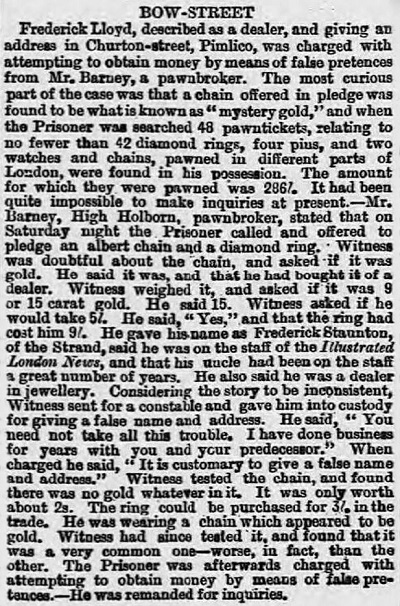
Our correspondent notes that further information is available on the website The Proceedings of the Old Bailey.
9475. The Grandmaster title
From Ola Winfridsson (São Paulo, Brazil):
‘Further to your Chess Grandmasters article, I have browsed through some of the early issues of Tidskrift för Schack (Sweden) for instances of the term “stormästare” (grandmaster) prior to the St Petersburg, 1914 tournament.
On page 141 of the 6/1907 issue the games section began with “Stormästareturneringen i Ostende” (The Grandmaster Tournament in Ostend), and page 50 of the 2/1907 issue had this news item:
“Ostende. Som förut är nämnt skall årets turneringar här börja redan den 15 maj. Turneringsledare blir L. Hoffer. Föreslagna äro: en stormästareturnering med 6 deltagare, 4 omgångar och 10.000 fr i priser samt dessutom 1.200 fr som ersättning för omkostnader; en mästareturnering med 30 deltagare ...” [“Ostend. As previously mentioned, this year’s tournaments will begin as early as 15 May. The tournament director will be L. Hoffer. The following are proposed: a grandmaster tournament with six players, quadruple round-robin ...; a master tournament with 30 participants ...”]
That item also stated:
“Segraren i stormästareturnering skall erhålla titeln ‘Turnier-Champion’ och erhåller som sådan guldmedalj och diplom.” [“The winner of the grandmaster tournament will receive the title ‘Turnier-Champion’ and, as such, receive a gold medal and a diploma.”]
The use of “stormästareturnering” without further explanation suggests that “stormästare” was already a familiar term. I can find no reference in Tidskrift för Schack to Tsar Nicholas II having bestowed the title of Grandmaster on the five participants in the final phase of the St Petersburg, 1914 tournament.’
In his extensive coverage of the Ostend congress in the Field, Hoffer referred to the main event as the ‘Championship Tournament’. The book by the winner, Tarrasch, was entitled Das Champion-Turnier zu Ostende im Jahre 1907 (Leipzig, 1907). Throughout its 1907 coverage, La Stratégie used the term ‘tournoi-championnat’.
9476. A chess quiz and related questions
Four quiz questions:
1. How many competitors were there in the 1939 women’s world championship tournament?
2. Name the player referred to here: ‘He switched to milk in 1947. What was the effect?’
3. Which player died in his bath surrounded by women’s shoes?
4. Name the player who stated: ‘I think it was 1998 and 1999 I was the most active player in the country. I was playing 360-370 rated long-play games a year as well as about 250 rated Rapidplay games.’
Our purpose here is not to test readers’ chess knowledge
but to show that behind quiz questions there may lie
other, perhaps more interesting, questions.
Question 1: There were 20 competitors in the tournament, played in Buenos Aires and won by Vera Menchik. As reported in C.N. 150, this question was put to John Clarke (New Zealand) when he tackled the history of chess in Mastermind International, broadcast on BBC-1 on 3 June 1982. See too page 346 of the August 1982 BCM. Mr Clarke could hardly be blamed for not knowing the answer; contestants hoping to demonstrate their ability to retain, or inability to shed, information are at the mercy of question-setters, who may be ill-equipped for the task.
Question 2: The milk question was posed by Raymond Keene in a prize quiz on page 99 of the Spectator, 19-26 December 1987. The answer given on page 51 of the 23 January 1988 issue was Alekhine, with an explanation that 1947 was a ‘misprint’ for 1937.
Question 3: This was also from the Spectator quiz, in a section entitled ‘They’re all mad’. Regarding Morphy, see ‘Fun’. The milk and bath questions further illustrate what happens when a chess history/lore quiz is set by an individual with inadequate diligence and knowledge. In C.N. 1568 we commented about the Spectator quiz:
Of the 30 questions, under half could be called correct. Some were pure fiction, others had more than one answer, and others still were sheer speculation. John Roycroft has kindly authorized us to say that he has no quarrel with this assessment.
We are most grateful to him; after all, Mr Roycroft was one of the three prize-winners.
Question 4: This is a question of our own invention, but
how much invention does it contain? The claim ‘I was
playing 360-370 rated long-play games a year’ was made by
CJ de Mooi, the then President of the English Chess
Federation, in an interview with Sean Marsh on page 46 of
CHESS, March 2010. (On the following page he stated
that he had not kept any of his game-scores.) Is the claim
about so many hundreds of games credible? Is it provable?
If so, is it a record?
9477. Copenhagen, 1946
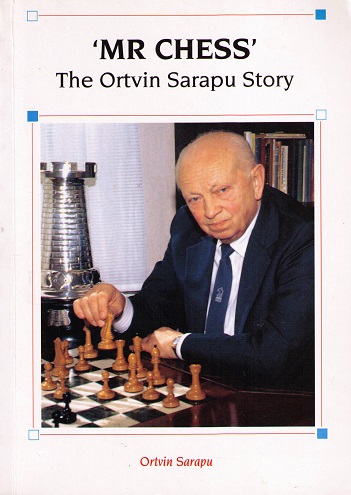
From Calle Erlandsson (Lund, Sweden):
‘Page 4 of ‘Mr Chess’ The Ortvin Sarapu Story by Ortvin Sarapu (Wainuiomata, 1993) states that he “won the Copenhagen championship and the five-minute lightning championship in 1946”.
I have not found a note about the lightning tournament, but it is clear that Jens Enevoldsen won the Copenhagen championship in 1946. The crosstable was given on page 124 of the August 1946 issue of Skakbladet:’
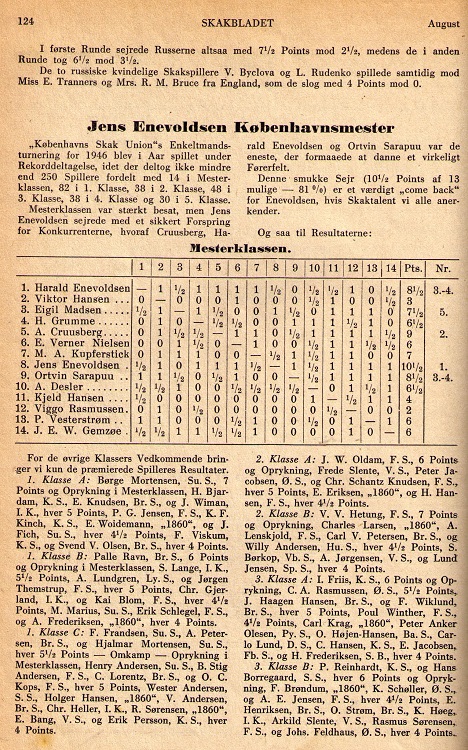
9478. Ortvin Sarapu
A photograph of Sarapu was given in C.N. 3444, from the front cover of his book Chess Championships 25 years of New Zealand Chess Championships 1952-1977:
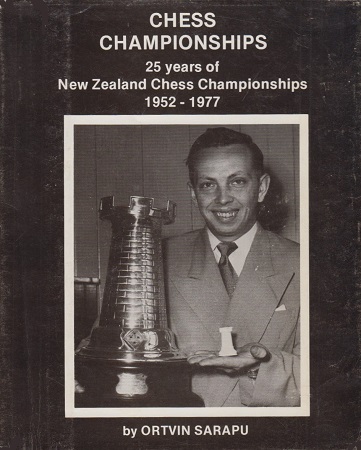
The book is undated and has no title page. Sarapu’s signature in our copy:
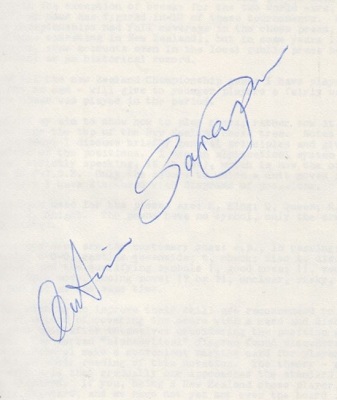
9479. Capablanca and Reshevsky
Gerard Killoran (Ilkley, England) draws attention to the photographs of Capablanca giving simultaneous exhibitions in the Illustrated World (1919), page 934, and the New York Times Pictorial Portfolio of the World (1922), page 410. The latter publication also has a fine portrait of Reshevsky.
9480. Halprin v Pillsbury
From page 80 of 500 Master Games of Chess by S. Tartakower and J. du Mont (London, 1952):
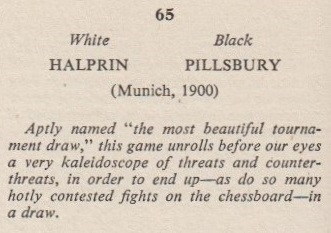
The game is well known (1 e4 e5 2 Nf3 Nc6 3 Bb5 Nf6 4 O-O Nxe4 5 d4 Nd6 6 dxe5 Nxb5 7 a4 d6 8 e6 fxe6 9 axb5 Ne7 10 Nc3 Ng6 11 Ng5 Be7 12 Qh5 Bxg5 13 Bxg5 Qd7 14 b6 cxb6 15 Nd5 exd5 16 Rfe1+ Kf8 17 Ra3 Ne5 18 Rxe5 dxe5 19 Rf3+ Kg8 20 Bh6 Qe7 21 Bxg7 Kxg7 22 Rg3+ Kf8 23 Rf3+ Kg7 24 Rg3+ Kf8 Drawn), but where was it first described as ‘the most beautiful tournament draw’?
9481. Guinness World Records
A FIDE report dated 13 March 2015 (richly illustrated but poorly written) stated:
‘On March 11, the FIDE President left Reykjavik for London where he visited the editorial office of the Guinness World Records and congratulated the Records with its 60th anniversary. The talks were about the possible cooperation between FIDE and Records that meets the interests of both sides. The Records’ representatives would like to get the various information about chess and proposed to set the necessary criteria for the certification of records and their submission for publishing.’
In two photographs Kirsan Ilyumzhinov beamingly held a copy of Guinness World Records 2015.
Since 2004 we have been posting annual accounts of the chess content of Guinness World Records, and it can now be mentioned that the 2016 book has just been published.
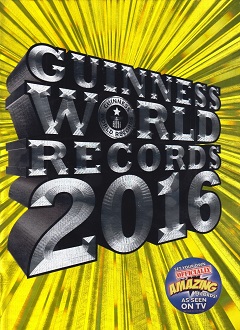
Number of chess-related items in the 2016 edition: zero.
9482. Photographic archives (7)
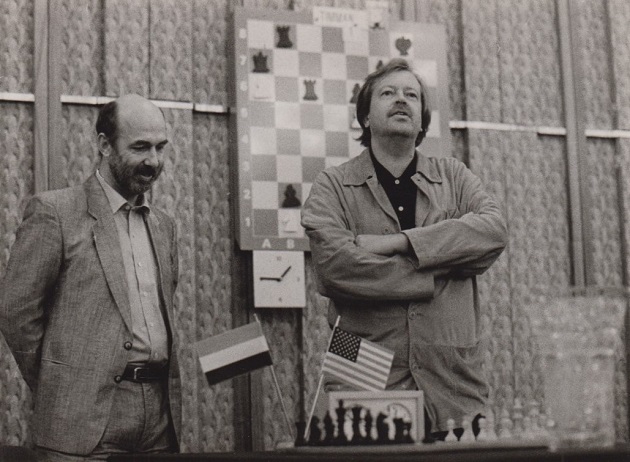
Lubomir Kavalek and Bessel Kok
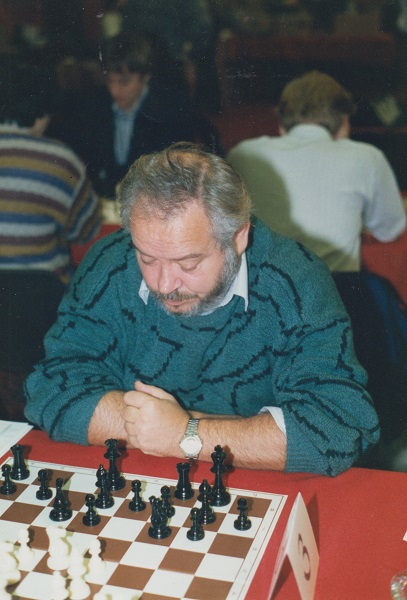
Ivan Nemet
9483. Mate in two (C.N. 9469)

This composition, dated 1958, was taken from pages 80-81 of Andradiana (Sutton Coldfield, 1961), in the section headed ‘Multiple Key-Move Problems’. Page 81 stated:
‘White has (about) 84 possible moves – of which only one (namely, 1 R-B6) fails to fulfil the contract. This is defeated by 1...R-B2. A problem, one imagines, infinitely more difficult to compose than to solve.’
Michael McDowell (Westcliff-on-sea, England) informs us that a computer check shows that there are 92 solutions, plus 1 Rc6. He also points out that the ‘Maximum Keys and Variations’ section on page 28 of Ultimate Themes by T.R. Dawson (Thornton Heath, 1938) has this composition by E. Luukkonen:

It will be appreciated if a reader can supply a scan of the original publication in the Finnish magazine.
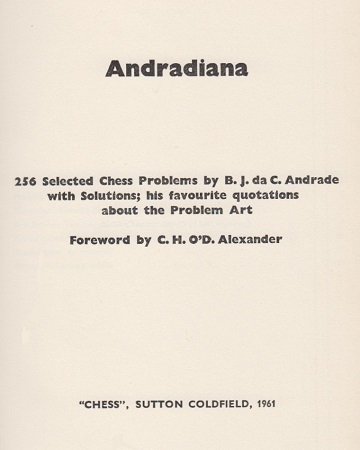
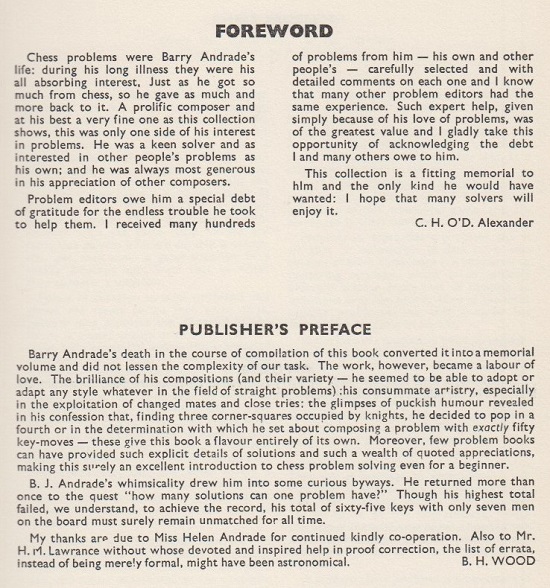
Andrade’s death was reported on page 125 of CHESS, 5 January 1961:
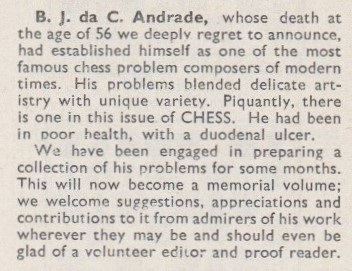
He had an entry in Chess Personalia by Jeremy Gaige (Jefferson, 1987), but more detailed information was included in the unpublished 1994 edition:
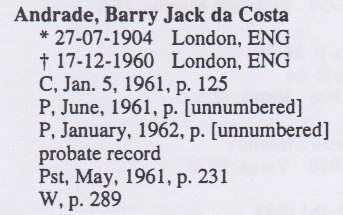
9484. 1 e4 Nc6
Jean-Pierre Rhéaume (Montreal, Canada) draws attention to the entry on page 152 of the Dictionnaire des échecs by François Le Lionnais and Ernst Maget (Paris, 1967):
‘Fischer-Nimzovitch (Défense)
1. é4, Cç6. On tend de nos jours à ne plus conserver à ce coup que le nom de Nimzovitch qui lui a trouvé de nouvelles justifications. Quant à Fischer (ou Fisher), c’est un joueur allemand qui vivait au XIXe siècle.’
Our correspondent asks for information about Fischer and the reasons for associating his name with 1 e4 Nc6.
References to Eduard Fischer (why the Dictionnaire added ‘Fisher’ is unclear) are frequently found in German-language sources. A prime example is the 76-page book Die Fischer-Nimzowitsch-Verteidigung by Georg Deppe (Heidelberg, 1979):
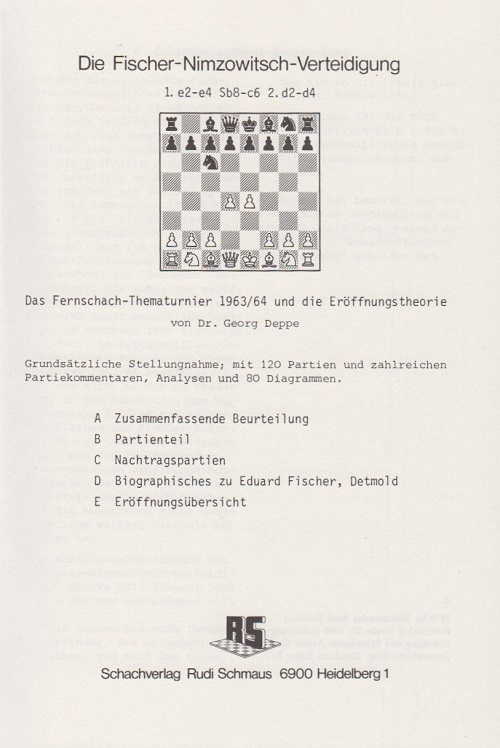
Below is the first part of a note on Fischer (page 73):

As to volume 25 of the Handbuch der
Schach-Eröffnungen by Rolf Schwarz (Hamburg, 1969)
...
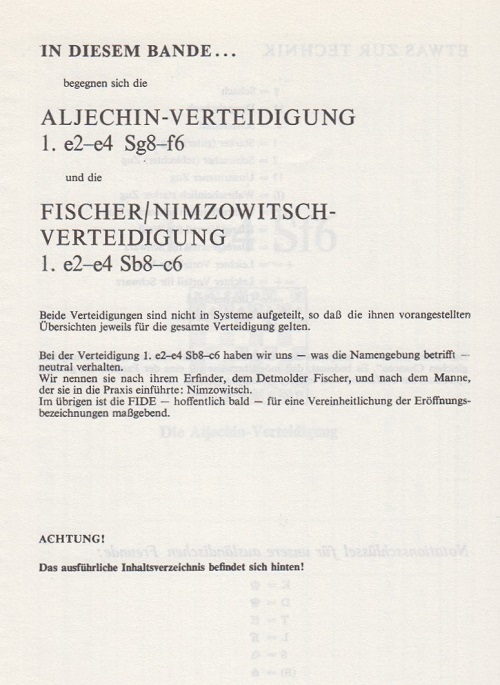
... the following was on page 187:

Hugh Myers’ books on 1 e4 Nc6 discussed such references to Fischer. The passage below, for instance, comes from page i of The Nimzovich Defense to 1. e4 (Yorklyn, 1995):
‘A couple of things should be said about this opening’s name. Nimzovich was by no means its originator or inventor, as he has been called in some books. It was at least known as far back as the sixteenth century. In the 1800s, several players introduced it into master competition before Nimzovich was born (1886). Nevertheless, Nimzovich Defense is widely applied to 1 e4 Nc6, and there is no clearly preferable name. It’s called The Fischer Defense, or Fischer-Nimzowitsch Defense, in Germany. That’s apparently because Wilfried Paulsen learned about 1 e4 Nc6 from Eduard Fischer during 1858-59. Then he and his brother Louis Paulsen played it in serious competition in the late 1860s. They gave credit to Fischer. The Oxford Companion to Chess (1984) states that 1 e4 Nc6 was “used regularly by the German player Eduard Fischer (1831-97)” and that it was “reintroduced by Nimzowitsch”. The problem with crediting Fischer, primarily known as a correspondence player, for his regular use of 1 e4 Nc6 is that I have never seen the score of a single game in which he played it. It’s doubtful that such a score would prove much anyway; 1 e4 Nc6 games by other players had been published in the 1840s. They are in this book.
As for Nimzovich, I don’t know that it should be said that he “reintroduced” 1 e4 Nc6 (others besides Fischer and the Paulsens had played it; Kennedy and Williams played it in the 1840s, and there are records of games with it by other players in every decade since then), but there’s no doubt that he was the first to play it with frequent success in major international competition. That is an acceptable reason for naming it The Nimzovich Defense.’
In the next paragraph Myers briefly discussed the spellings Nimzovich and Nimzowitsch, mentioning too Niemzowitsch, Niemtsowitsch, Nimzovitsch and Nimzovitch.
Regarding Modern Chess Openings, Eduard
Fischer’s name was introduced in the 11th edition (1972),
edited by Walter Korn. From page 192:
‘This “bizarre” defence was first advocated by the German master Fischer in the last century. Nimzowitsch subjected it to deep study in 1919 and came to the conclusion that it was sound.’
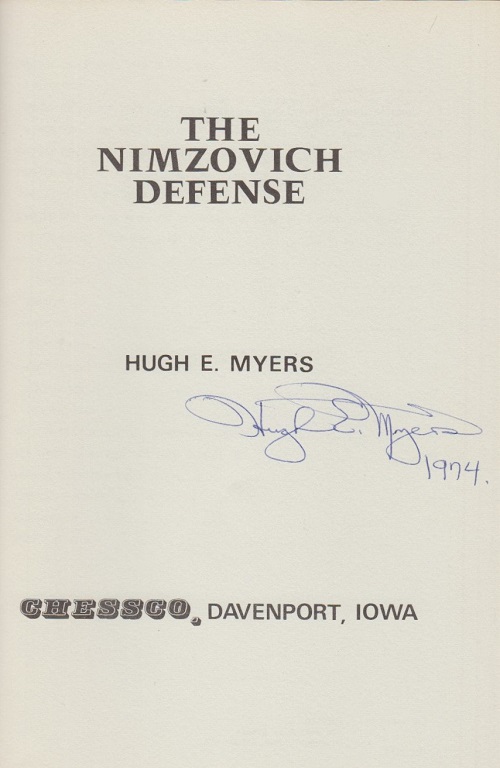
Below are the books on this opening in our collection:
- The Nimzovich Defense by H.E. Myers (Davenport, 1973)
- La défense Nimzovitch du pion roi by H.E. Myers (Besançon, 1979)
- Die Fischer-Nimzowitsch-Verteidigung by G. Deppe (Heidelberg, 1979)
- The Nimzowitsch Defence by T. Harding (London, 1981)
- Nimzovich Defence by T. Kapitaniak (Nottingham, 1982)
- Nimzovich’s Defence to 1. e4 by H.E. Myers (Yorklyn, 1985)
- Nimzowitsh Defence (Schifflange, 1994)
- The Nimzovich Defense to 1. e4 by H.E. Myers (Yorklyn, 1995)
- 1...Sc6! ...aus allen Lagen by H. Keilhack and R. Schlenker (Schwieberdingen, 1995 and 2003)
- A Complete Defence for Black by R. Keene and B. Jacobs (London, 1996)
- play 1...Nc6! by C. Wisnewski (London, 2007).
Of the above books the only one mentioned in the ‘Bibliography’ on page 4 of Christophe Wisnewski’s volume is the second edition of 1...Sc6! ...aus allen Lagen.
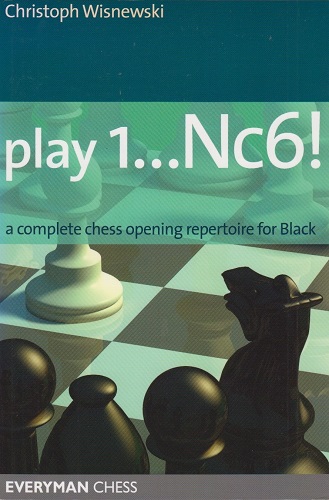
9485. Bibliographies
Another Everyman book (one of several, alas) whose bibliography raises questions about the author’s research and, even, about his interest in the subject is Karpov move by move by Sam Collins (London, 2015):
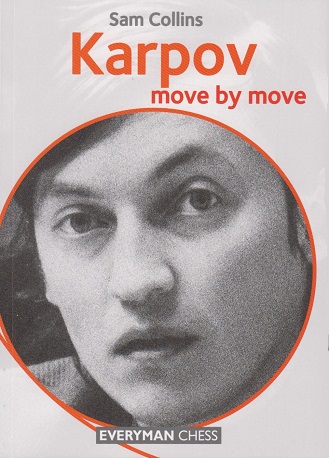
Our feature article lists some 40 books about Karpov. Collins’ bibliography (page 5) mentions one.
9486. Fischer v Bustos
The game below has been provided by Carlos Drake (Buenos
Aires), who received it from Bustos in a letter dated 1
November 2007. It was played in a 20-board simultaneous
exhibition during Fischer’s visit to Argentina.
Robert James Fischer – Carlos Alberto Bustos
Balcarce, 1 December 1971
Pirc Defence
1 e4 d6 2 d4 Nf6 3 Nc3 g6 4 f3 Bg7 5 Be3 O-O 6 Qd2 Nc6 7 O-O-O e5 8 d5 Ne7 9 g4 Nd7 10 h4 f5 11 gxf5 gxf5 12 exf5 Nxf5 13 Bg5 Nf6 14 Bd3 a6 15 h5 Qe8 16 Nge2 Rf7 17 Rdg1 Kh8
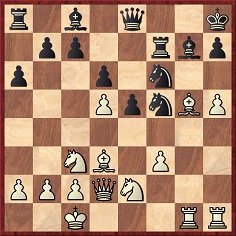
18 h6 Bf8 19 Rg2 Bd7 20 Rhg1 Be7 21 Ng3 Nxg3 22 Rxg3 Nh5 23 R3g2 Bf5 24 Bxf5 Rxf5 25 Ne4 Qf7 26 Bxe7 Qxe7 27 Ng5 Nf4 28 Rg4 Rg8 29 Nf7+ Qxf7 30 Rxg8+ Qxg8 31 Rxg8+ Kxg8 32 Qb4 b6 33 Qa4 Ng6 34 Qxa6 Nf8 35 Qc8 Rf7 36 a4 Re7 37 b4 Kf7 38 a5 bxa5 39 bxa5 Rd7 40 a6 Ke7 41 a7 Resigns.
9487. Chess play and chess history
Wanted: quotes from chess literature along similar lines to these:
- ‘We perceive after a careful consideration of the evolution of the chess mind that such evolution has gone on, in general, in a way quite similar to that in which it goes on with the individual chessplayer, only with the latter more rapidly.’
Source: page 1 of Modern Ideas in Chess by R. Réti (London, 1923).
- ‘... the individual chessplayer ... passes through the same development of his own life-history as the chess world has experienced as a collective group.’
Source: page 51 of How to Improve Your Chess: Second Steps by I.A. Horowitz and F. Reinfeld (New York, 1952).
- ‘The development of a chessplayer runs parallel with that of chess itself; a study of the history of playing methods therefore has great practical value.’
Source: page ix of The Development of Chess Style by M. Euwe (London, 1968).
9488. Photographic archives (8)
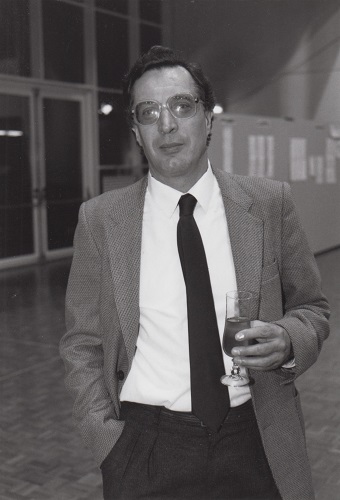
István Csom
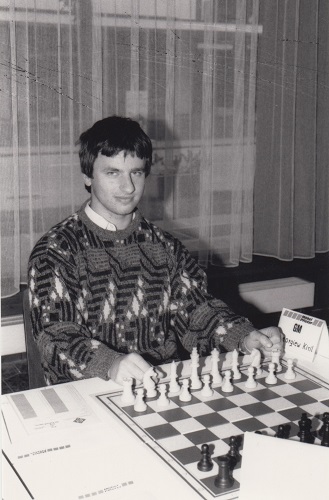
Kiril Georgiev
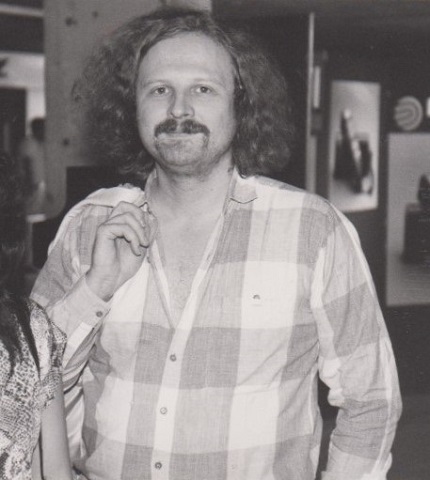
Tony Miles
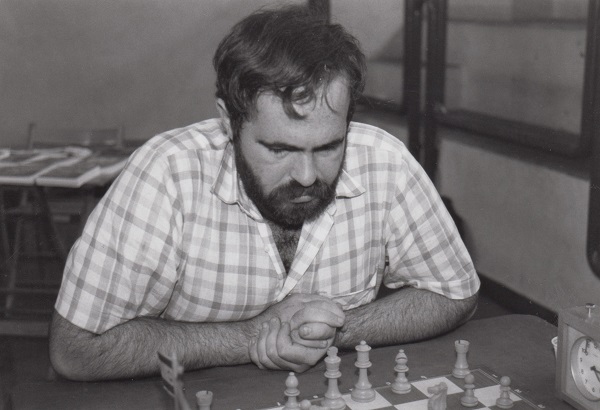
Lev Psakhis
9489. Boomerang combination

Black has played 1...b4.
If 2 Rxe8 (with a view to 2...Kxe8 3 Bb5+) Black plays 2...Rxa6+. White’s winning line is therefore 2 Bc4+ Kf8 3 Rxe8+.
The position is familiar from, for instance, page 92 of Combinations The Heart of Chess by Irving Chernev (New York, 1960), in the chapter entitled ‘Boomerang Combinations’. The caption was ‘Komke-Mai, Berlin, 1931’.
Kurt Richter gave the conclusion on pages 47-48 of Kombinationen (Berlin and Leipzig, 1936), with the additional information that the event was the Summer Tournament of the Berlin Chess Association:
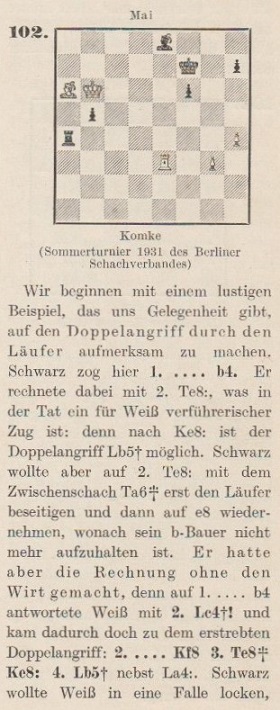
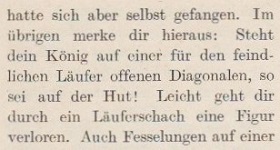
When the tournament was briefly referred to on page 292 of the October 1931 Deutsche Schachzeitung one of the players mentioned was ‘May’:

Is the full game-score available?
9490. Monte Carlo, 1903
A photograph opposite page 47 of the American Chess Weekly, 21 May 1903:

We are grateful to the Cleveland Public Library for providing a high-resolution scan.
The photograph was omitted from the 1983 compilation/reprint by Edition Olms Zürich The Monte Carlo Tournament of 1903. According to pages 103-104 of that book (material originally published in the American Chess Weekly, 18 June 1903) the pairings on 14 February 1903 included Mason v Reggio, whereas the above caption, confusingly written in several respects, places them on different sides of the room.
9491. C.J.S. Purdy on Sam Loyd
From page 282 of Chess World, 1 December 1948:
‘Not to care for Sam Loyd’s chess problems is, in a chessplayer, simply ignorance – to know them is to like them. Even the most besotted anti-problemist must count Loyd an exception. Sam Loyd’s ingenuity was really incredible. In the puzzle world he was what Shakespeare is in literature.’
9492. The Laws of Chess
It is to be hoped that an historically-minded expert on the laws of chess will one day produce a book chronicling how the game’s rules have been codified over the centuries: the faulty pioneering work, drafting errors, ambiguities, misunderstandings, translations, disputes, clarifications, improvements, etc. that have led to the present FIDE text.
The complexity of the subject is well illustrated by the 203-page book Aprenda ajedrez by Luciano W. Cámara (Buenos Aires, 1977). The manual went through many editions and adopted an interesting approach: within the rules themselves Cámara incorporated interpretations formulated by FIDE, as well as practical examples from play.
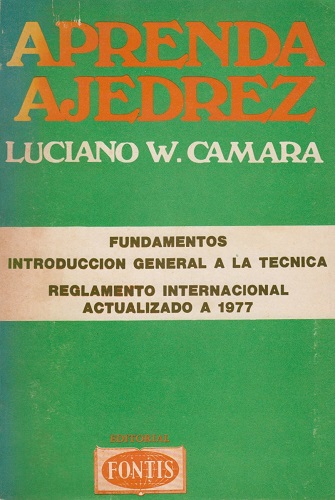
Below are sections on how the pieces move (pages 123-124) and how a game is lost (pages 147-148):


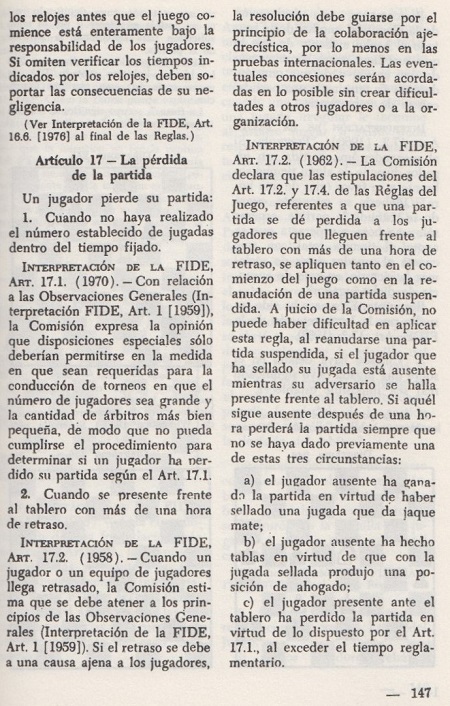
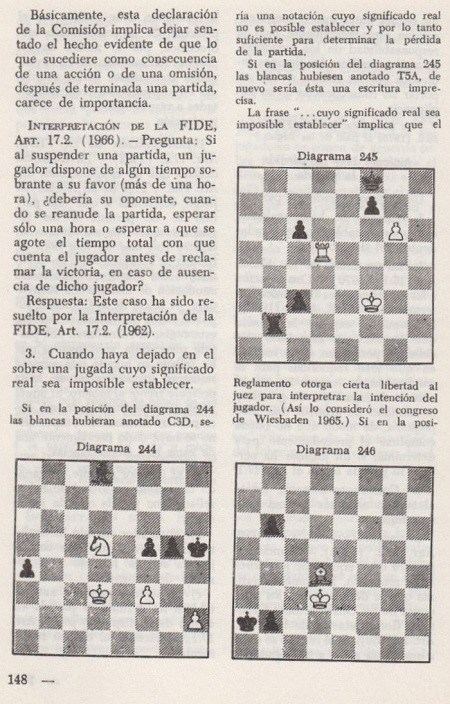
Our copy of that 1977 edition, the fifth, was inscribed by Cámara to FIDE’s Rules Commission:
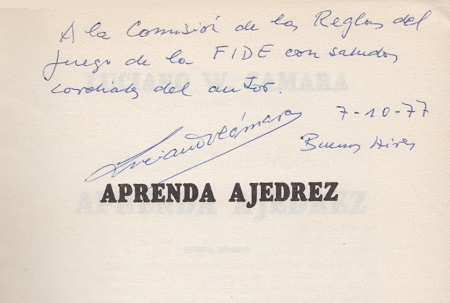
9493. Rc6, Sc6 and Nc6

Thomas Ristoja (Helsinki) informs us that he translated Heikki Westerinen’s 1972 booklet Rc6!? from Finnish into Swedish, but that his name was omitted from the Swedish edition, which was entitled Nc6!?. The work concerns the opening 1 d4 Nf6 2 c4 g6 3 Nc3 Bg7 4 e4 d6 5 f3 O-O 6 Be3 Nc6.
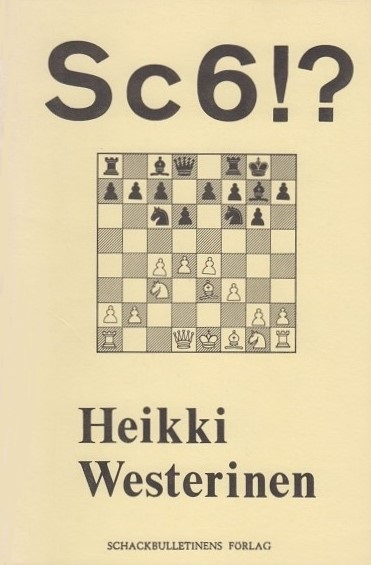
As noted in A Sorry Case, Westerinen has never written a monograph on 1 e4 Nc6, contrary to the assertion on page 50 of Unorthodox Openings by Joel Benjamin and Eric Schiller (London, 1987):
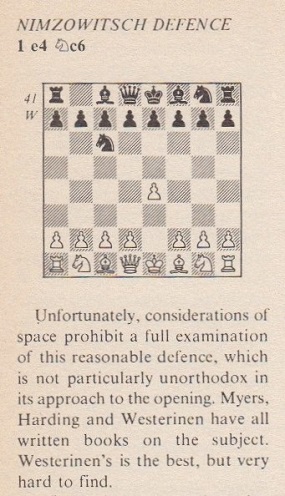
9494. A 1928 group photograph
John Donaldson (Berkeley, CA, USA) has forwarded this photograph:

Many of the players and FIDE officials who gathered in The Hague in 1928 are easily recognized, but before embarking, with readers’ assistance, on preparation of a key, we should like to know whether a full or partial caption already exists.
9495. Error and perfection
From page 201 of The Chess Masters on Winning Chess by Fred Reinfeld (New York, 1960):
‘It is curious that there are so many misconceptions about chess, not only among nonplayers but even among its devotees. Perhaps the most indestructible of these legends is that chess is a rigorous duel of mighty intellect clashing with another mighty intellect. A won game is therefore, according to this version, a masterpiece of logic, forethought, calculation, precision, and the like.
This is what chess may become some day when it is played only by electronic computers. But as long as it is played by human beings, chess will remain what it has always been – a struggle full of mistakes, oversights, errors of judgment, omissions, inexactitudes, vicissitudes, a blunder answered with a bigger blunder.
We may tsk-tsk over these lapses, yet – dare we say it? – we rather enjoy seeing our betters get their comeuppance from time to time. And in any event, we realize sooner or later, from games like the following one, that most of the color, suspense, tension and kaleidoscopic variety of this wonderful game arise from the mistakes of the players. Nothing palls like too much perfection; we can best appreciate it in patches that stand out against a background of struggle, error and befuddlement.’
Reinfeld then gave Yates v Kmoch, London, 1927, with a critical examination of the latter’s notes. Kmoch had originally annotated the game on pages 237-239 of the Wiener Schachzeitung, August 1927.
9496. Accusation of fraud (C.N. 9474)
John Townsend (Wokingham, England) reports that in the London Gazette of 3 February 1891 (‘The Bankruptcy Acts, 1883 and 1890. Receiving Orders’) there was an entry under ‘Debtor’s Name’ for Frederick Charles Howard Staunton. The column headed ‘Address’ had the following:
‘Lately residing at 5 Churton-street, Pimlico, Middlesex, present place of residence the Petitioning Creditor has been unable to ascertain.’
The same street was mentioned in the news report shown in C.N. 9474.
9497. Photographic archives (9)
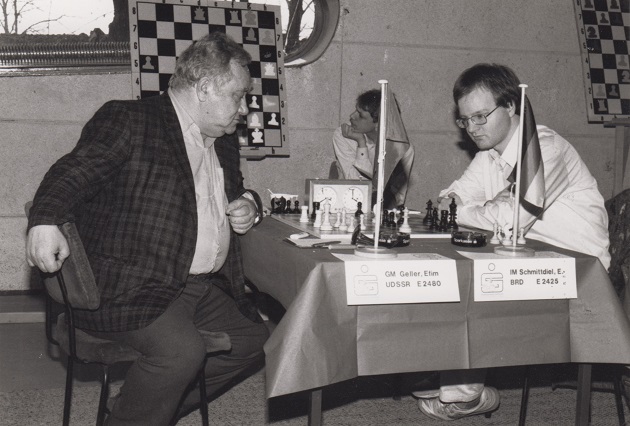
Efim Geller, Eckhard Schmittdiel (Dortmund, 1989)
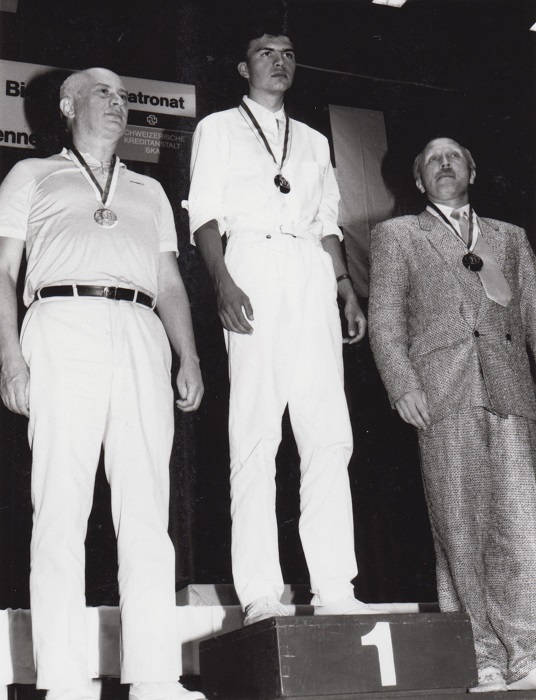
Boris Gulko, Ivan Sokolov, Vladimir Tukmakov (Biel, 1988)
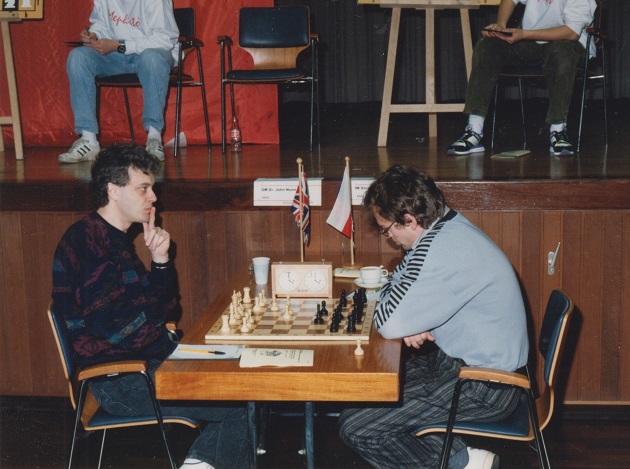
John Nunn, Igor Štohl (Dortmund, 1991)
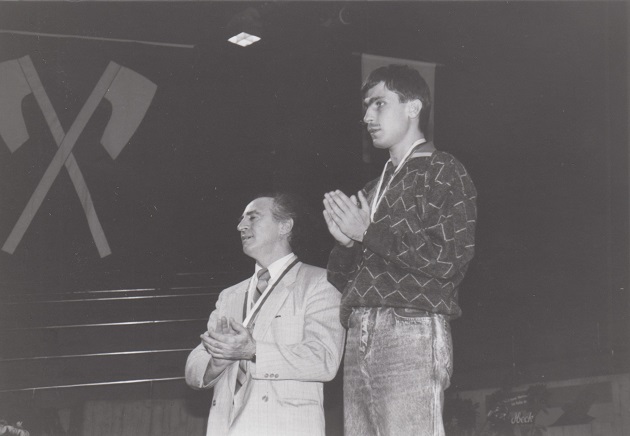
Lev Polugayevsky, Vassily Ivanchuk (Biel, 1989)
9498. Boomerang combination (C.N. 9489)
From Alan McGowan (Waterloo, Canada):
‘It seems that there were players named Mai and May in Berlin chess circles at that time.
The Komke v Mai combination (but not the full game) was in the September 1931 issue of Schachwart, page 166, with the spelling “Mai”. Page 199 of the October 1931 issue referred to his having played in the Summer Tournament in Berlin.
Elsewhere in that year’s issues of Schachwart (June, page 117 and November, page 213) there were references to a player named “May” of the Walbrodt Club.
I looked for an occurrence of both names on the same page, and came close: in the section on club news in the January 1931 issue of Schachwart, page 15, there was a reference to Hans May of the Walbrodt Club. On the following page, in connection with the Berlin Chess Association Winter Tournament, “Mai” was mentioned.
Pages 298-299 of Deutsche Schachblätter, 1 October 1931 had a report on the Summer Tournament and gave “Mai”.’
9499. A 1928 group photograph (C.N. 9494)
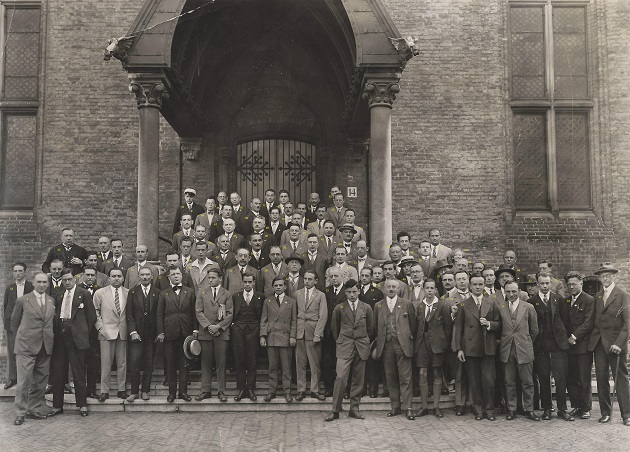
A feature article has been created, and a start made with identification.
9500. Players and Pawns
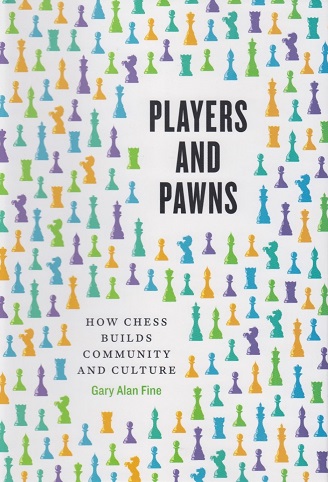
The dust-jacket of Players and Pawns (Chicago and London, 2015) states that ‘Gary Alan Fine is the John Evans Professor of Sociology at Northwestern University’ and introduces his book thus:
‘A chess match seems as solitary an endeavor as there is in sports: two minds, on their own, in fierce opposition. In contrast, Gary Alan Fine argues that chess is a social duet: two players in silent dialogue who always take each other into account in their play. Surrounding that one-on-one contest is a community life that can be nearly as dramatic and intense as the across-the-board confrontation.’
Beyond such woolliness, the book is striking for a heavy USA-centric approach, the author’s unfamiliarity with chess history and lore, and a staggering lack of discernment in the sources cited.
As demonstrated by the concluding ‘Notes’ section (pages 227-261), the Professor has no interest in, or access to, primary sources and makes do with material unquestioningly derived from familiar books and webpages which are themselves derivative. Those ‘sources’ in the Notes section include an Internet quotations site (itself devoid of sources) and such embarrassments as ‘Internet Chess Club discussion boards, 2010’.
Professor Gary Alan Fine is unrelated to Reuben Fine, he states on page 1. He makes frequent, naively trusting, mention of his namesake, although his interest has its limits. Page 205 discusses the wonder of databases, which ‘have replaced wood pulp’: ‘Fully 389 of Reuben Fine’s games are archived ...’ There is no awareness of Aidan Woodger’s carefully researched monograph on Reuben Fine, published by McFarland & Company, Inc. in 2004, which has well over twice as many games by Fine as the ‘fully 389’.
McFarland books are of no concern to Professor Fine, who
instead goes as far down-market as possible for his raw
material and pseudo-sources. No would-be facts have been
scrutinized with care.
On page 114 he writes:
‘As Rudolf Spielmann advised, “Play the opening like a book, the middle game like a magician, and the end [sic] like a machine”.’
A superscript reference takes the reader to a source note on page 246:
‘Quoted in Kasparov, How Life Imitates Chess, 119.’
That is all. However, as demonstrated in our feature article on How Life Imitates Chess, page 119 of the former world champion’s book (US edition) was wrong, having incorrectly and sourcelessly copied earlier false attributions of the quote to Spielmann, even though the truth had long since been established. (See too Chess: the Need for Sources.)
How can anyone, let alone a Professor, be content to use
the words ‘Quoted in’, followed by an unverified secondary
source? Is that Professor Fine’s customary approach, or
only when dealing with chess? Readers are unlikely to care
whether he ‘argues that chess is a social duet’, or that
it is a social solo, or that it is anything else of his
choosing, but basic academic standards can reasonably be
expected. The book has been published by the University of
Chicago Press.
Our minuscule sample from Players and Pawns concludes with a line from page 169, regarding the title ‘grandmaster’:
‘... in 1914 Czar Nicholas II awarded the title in Russia. It became an official designation in 1950 by edict of the World Chess Federation.’
The source for that information is specified, on page 255, as ‘Olson, The Chess Kings, 95’. Yet what appears on page 95 of The Chess Kings by Calvin Olson (Victoria, 2006) is something very different:
‘The story regarding the Czar has no foundation and must be relegated to the category of fiction.’
9501. Misconceptions about chess (C.N. 9495)
Another observation by Fred Reinfeld, from page 158 of The Treasury of Chess Lore (New York, 1951):
‘Of all the many misconceptions about chess, the most remarkable is the fallacious view that this game requires exact calculation and scientific thinking from its devotees. The fact is that even master chess evokes such responses as prejudice, impulse, bad temper and fatalism to an astonishing degree.’
9502. Reinfeld on Purdy
Also from The Treasury of Chess Lore (page 215):
‘For years I have been proclaiming that the Australian Purdy is the world’s outstanding writer on chess. His work is alive with ideas, crackling with wit and good humor, and notable for its originality and clarity.’
9503. Koltanowski
Bruce Monson (Colorado Springs, CO, USA) sends a bizarre article by George Koltanowski, concerning ‘a prewar living game’ between Capablanca and Nimzowitsch, from page 11 of the 25 September 1966 edition of the San Antonio Light:
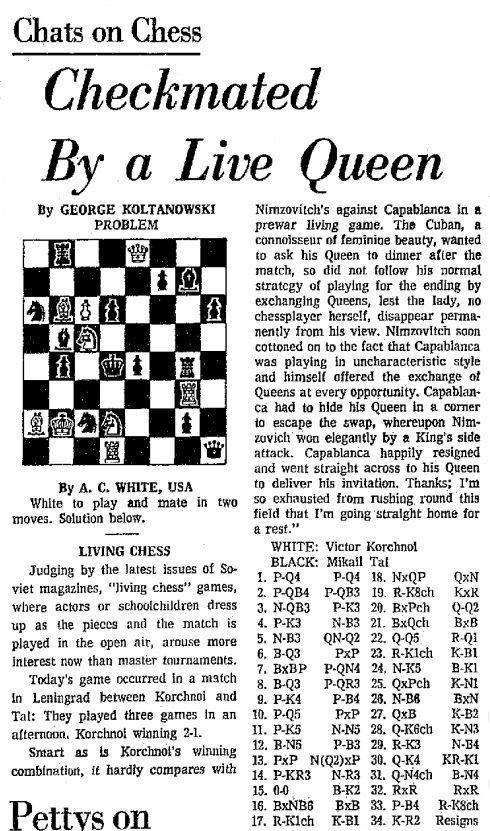
9504. The Hague, 1928 (C.N.s 9494 & 9499)
Richard Forster (Zurich) provides from his collection a photograph of seven Swiss chess figures in The Hague, at the same location (the Ridderzaal):
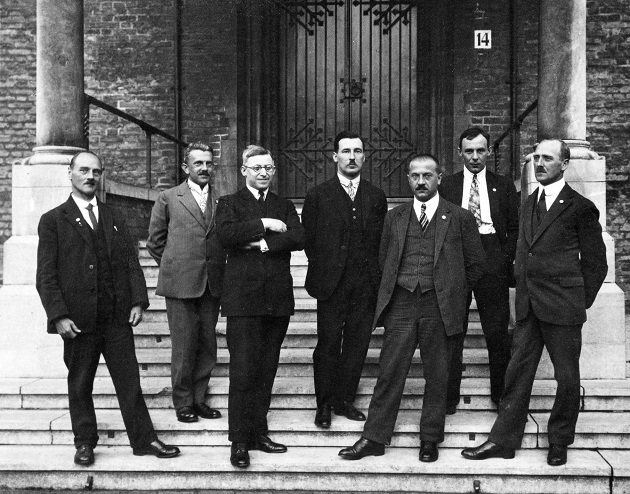
From left to right: Moriz Henneberger, Erwin Voellmy, William Rivier, Oskar Naegeli, Walter Michel, Fritz Gygli, Walter Henneberger
9505. Lasker v Schlechter
Emanuel Lasker – Carl Schlechter
Tenth match-game, Berlin, 8, 9 and 10 February 1910
Queen’s Gambit Declined
1 d4 d5 2 c4 c6 3 Nf3 Nf6 4 e3 g6 5 Nc3 Bg7 6 Bd3 O-O 7 Qc2 Na6 8 a3 dxc4 9 Bxc4 b5 10 Bd3 b4 11 Na4 bxa3 12 bxa3 Bb7 13 Rb1 Qc7 14 Ne5 Nh5 15 g4 Bxe5 16 gxh5 Bg7 17 hxg6 hxg6 18 Qc4 Bc8 19 Rg1 Qa5+ 20 Bd2 Qd5 21 Rc1 Bb7 22 Qc2 Qh5 23 Bxg6 Qxh2 24 Rf1 fxg6 25 Qb3+ Rf7 26 Qxb7 Raf8 27 Qb3 Kh8 28 f4 g5 29 Qd3 gxf4 30 exf4 Qh4+ 31 Ke2 Qh2+ 32 Rf2 Qh5+ 33 Rf3 Nc7 34 Rxc6 Nb5 35 Rc4 Rxf4 36 Bxf4 Rxf4 37 Rc8+ Bf8 38 Kf2 Qh2+ 39 Ke1 Qh1+ 40 Rf1 Qh4+ 41 Kd2 Rxf1 42 Qxf1 Qxd4+ 43 Qd3 Qf2+ 44 Kd1 Nd6 45 Rc5 Bh6 46 Rd5 Kg8 47 Nc5 Qg1+ 48 Kc2 Qc1+ 49 Kb3 Bg7 50 Ne6 Qb2+ 51 Ka4 Kf7 52 Nxg7 Qxg7 53 Qb3 Ke8 54 Qb8+ Kf7 55 Qxa7 Qg4+ 56 Qd4 Qd7+ 57 Kb3 Qb7+ 58 Ka2 Qc6 59 Qd3 Ke6 60 Rg5 Kd7 61 Re5 Qg2+ 62 Re2 Qg4 63 Rd2 Qa4 64 Qf5+ Kc7 65 Qc2+ Qxc2+ 66 Rxc2+ Kb6 67 Re2 Nc8 68 Kb3 Kc6 69 Rc2+ Kb7 70 Kb4 Na7 71 Kc5 Resigns.
Thomas Niessen (Aachen, Germany) submits the above game-score and writes:
‘Lasker published this game in Pester Lloyd in three parts (moves 1-15 on page 8 of the Morgenblatt of 11 February 1910, moves 16-43 on page 2 of the Abendblatt of the same day, and moves 44-71 on page 2 of the Abendblatt of 12 February 1910). Schlechter published the game-score on page 219 of the Allgemeine Sport-Zeitung, 27 February 1910.
The first problem with the score occurs after 48 Kc2:
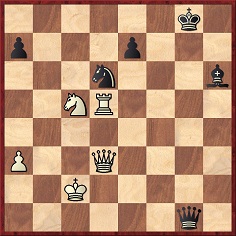
Instead of 48...Qc1+, which was given by both Lasker and Schlechter, some sources have 48...Qf2+. An example is the first volume of Kasparov’s My Great Predecessors, page 185 (C.N. 3180). This mistake was introduced shortly after the game in Deutsches Wochenschach, 13 February 1910, page 67:
The error was also in Národní listy, 15 February 1910, page 4:
The wrong move (48...Qf2+) was given too in Časopis českých šachistů, June 1910, page 97.
Other newspapers reported correctly 48...Qc1+, e.g. Berliner Tageblatt, 11 February 1910 (Morgen-Ausgabe, on the first, unnumbered page of the 1. Beiblatt) and The Times, 12 February 1910, page 12.
A second difference in the score appears quite often: instead of 66...Kb6, as Lasker and Schlechter recorded, 66...Kb7 is given. This mistake was also introduced very soon after the game, as is shown by the Nieuwe Rotterdamsche Courant, 12 February 1910 (Avondblad, B, page 1). None of the 1910 sources that I have mentioned contains both mistakes, but Chessbase Online Database, NICBase Online, chessgames.com and 365chess.com currently all do, as does Kasparov’s book referred to above (pages 185-186).
Both mistakes are also on page 854 of Emanuel Lasker: Denker, Weltenbürger, Schachweltmeister by Richard Forster, Stefan Hansen and Michael Negele (Berlin, 2009), although pages 61f. and 67 of Deutsches Wochenschach 1910 are given as its sources.
Lasker himself published a different score in Ost und West, April 1910, pages 236-237. Firstly, he saved a move with 31...Qh5+ 32 Rf3, instead of 31...Qh2+ 32 Rf2 Qh5+ 33 Rf3, and secondly he gave a different order for the moves 45-50, compared to moves 46-51 in Pester Lloyd.’
9506. Chessy words
With regard to Chessy Words, an early occurrence of ‘chessically’ comes from Rod Edwards (Victoria, BC, Canada), in Miron J. Hazeltine’s chess column on page 196 of the New York Clipper, 9 October 1858:
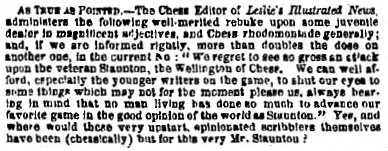
9507. Photographic archives (10)

Victor Korchnoi, Jóhann Hjartarson, Belgrade, 1987
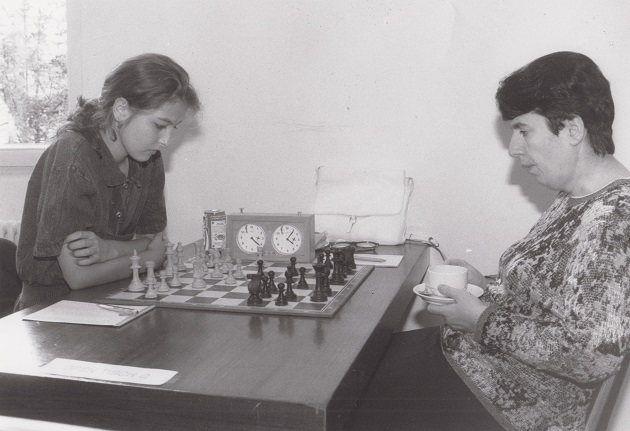
Adriana Domuta, Nona Gaprindashvili, Baden-Baden, 1991
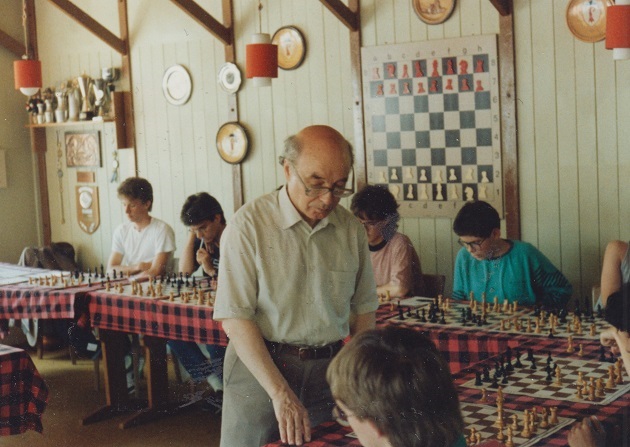
David Bronstein
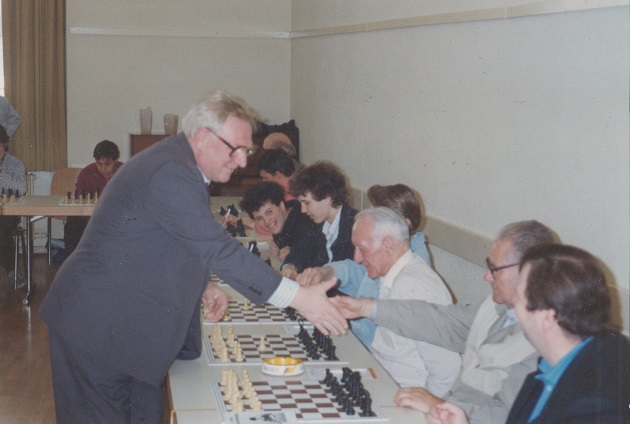
Alexei Suetin
9508. Jottings on a wonderful study
Pages 220-221 of An Invitation to Chess by Irving Chernev and Kenneth Harkness (New York, 1945):
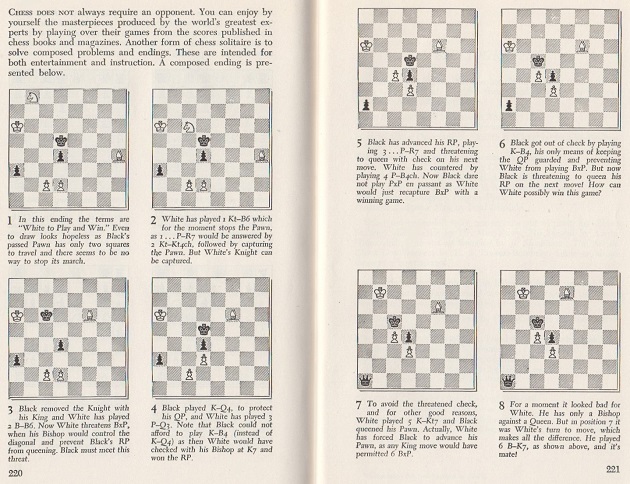
Remarkably, the co-authors saw no need to identify the composer of this wonderful study. This was not through ignorance, given that on page 25 of Chessboard Magic! (New York, 1943) Chernev had named the composer, Karl Artur Leonid Kubbel, and the publication in which the study had originally appeared:
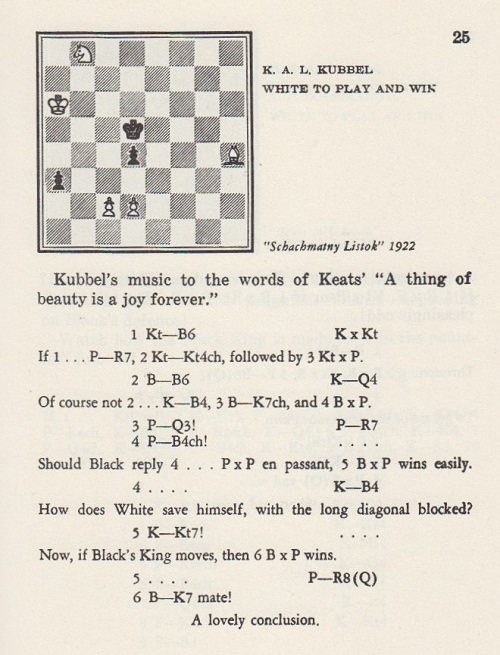
We are grateful to the Cleveland Public Library for providing the relevant (unnumbered) page of the 16 September 1922 issue of Shakhmatnyy listok:
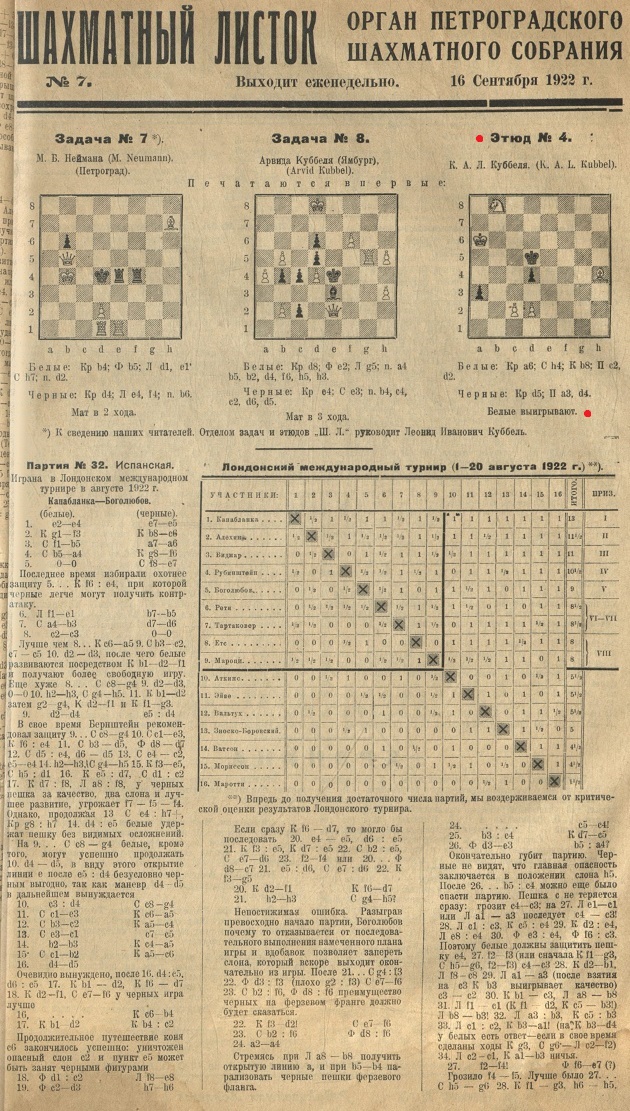
Leonid Kubbel’s Chess Endgame Studies by T.G. Whitworth (Cambridge, 1984) was welcomed in C.N. 744 as ‘a delight, excellently researched and produced’. A revised edition (Cambridge, 2004) incorporated substantial further material.
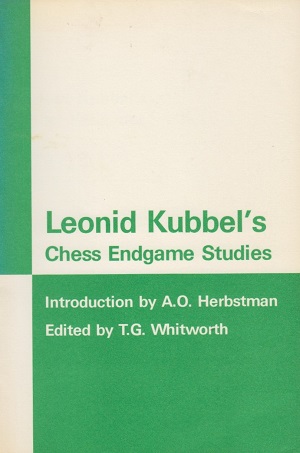
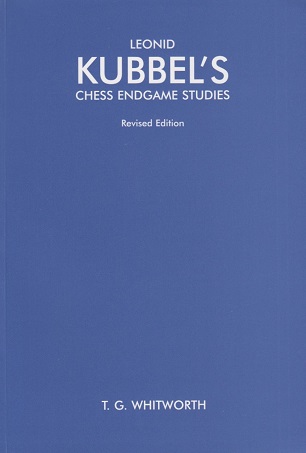
The above study from Shakhmatnyy listok was given by Timothy Whitworth on pages 25 and 24-25 respectively. From page 25 of the 2004 edition:
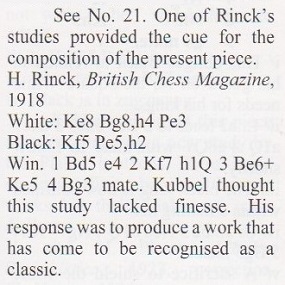
Below is the Rinck study as published on page 44 of the February 1918 BCM:
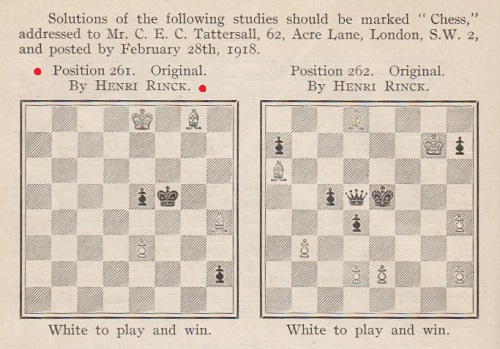
The solution on page 102 of the April 1918 BCM:
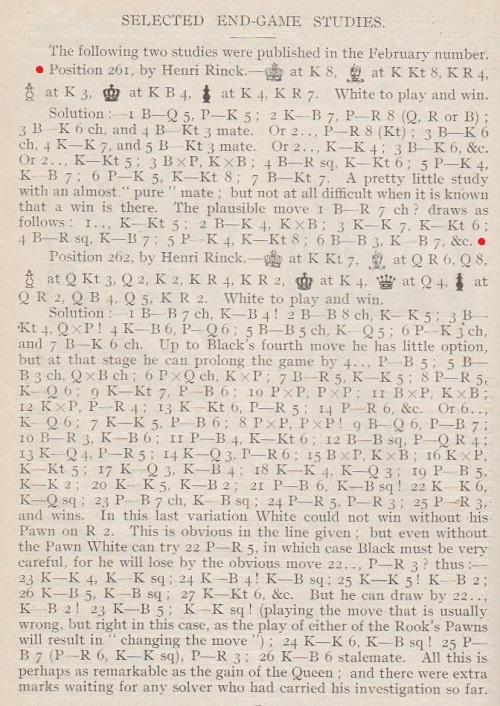
The present jottings conclude with a photograph of K.A. Leonid Kubbel from page 34 of Československý Šach, March 1930:
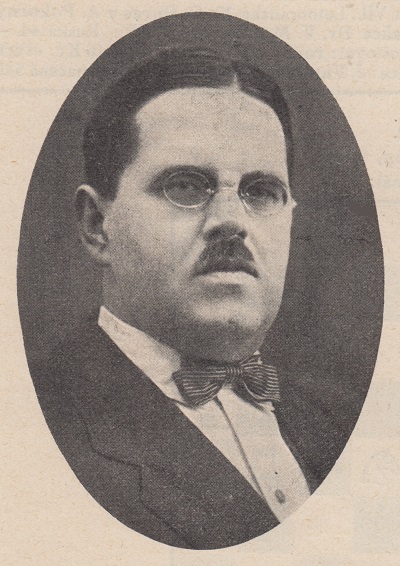
9509. Zukertort v Blackburne
A new feature article has just been posted: Zukertort v Blackburne, London, 1883.
| First column | << previous | Archives [134] | next >> | Current column |
Copyright: Edward Winter. All rights reserved.

